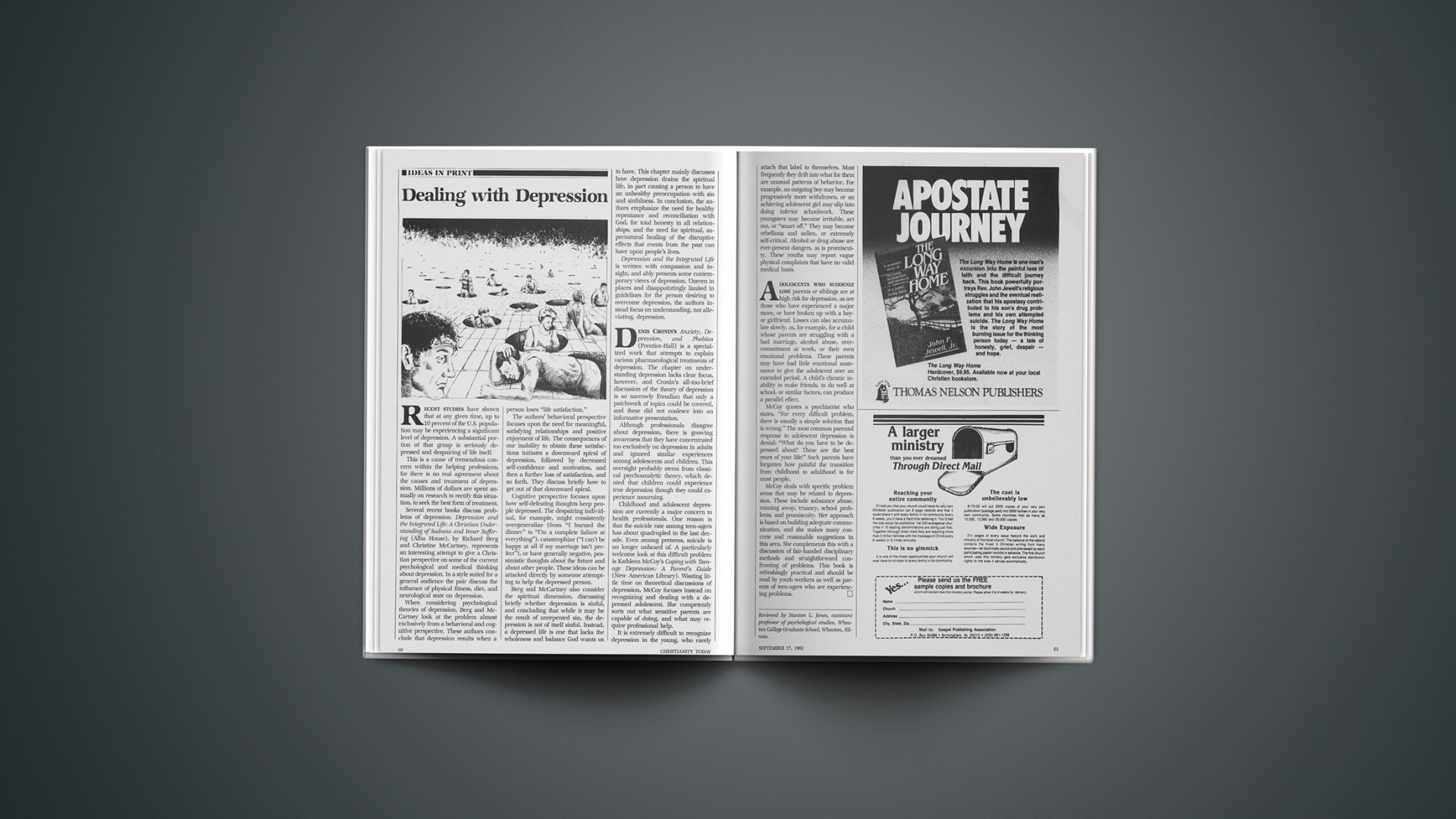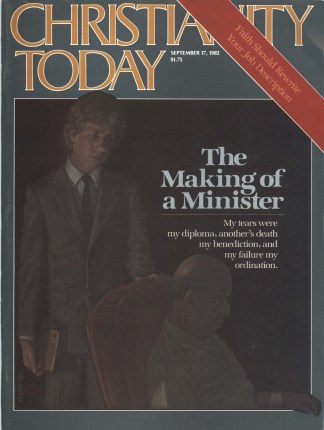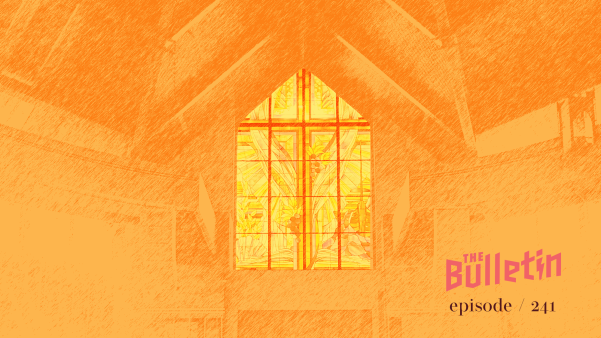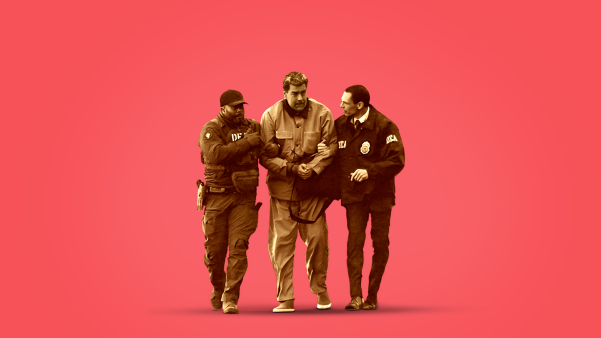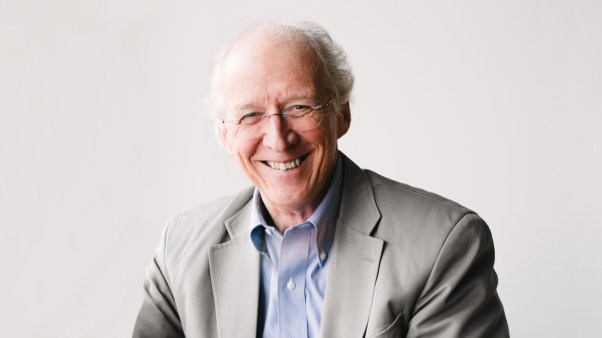Dealing With Depression
Recent studies have shown that at any given time, up to 10 percent of the U.S. population may be experiencing a significant level of depression. A substantial portion of that group is seriously depressed and despairing of life itself.
This is a cause of tremendous concern within the helping professions, for there is no real agreement about the causes and treatment of depression. Millions of dollars are spent annually on research to rectify this situation, to seek the best form of treatment.
Several recent books discuss problems of depression. Depression and the Integrated Life: A Christian Understanding of Sadness and Inner Suffering (Alba House), by Richard Berg and Christine McCartney, represents an interesting attempt to give a Christian perspective on some of the current psychological and medical thinking about depression. In a style suited for a general audience the pair discuss the influence of physical fitness, diet, and neurological state on depression.
When considering psychological theories of depression, Berg and McCartney look at the problem almost exclusively from a behavioral and cognitive perspective. These authors conclude that depression results when a person loses “life satisfaction.”
The authors’ behavioral perspective focuses upon the need for meaningful, satisfying relationships and positive enjoyment of life. The consequences of our inability to obtain these satisfactions initiates a downward spiral of depression, followed by decreased self-confidence and motivation, and then a further loss of satisfaction, and so forth. They discuss briefly how to get out of that downward spiral.
Cognitive perspective focuses upon how self-defeating thoughts keep people depressed. The despairing individual, for example, might consistently overgeneralize (from “I burned the dinner” to “I’m a complete failure at everything”), catastrophize (“I can’t be happy at all if my marriage isn’t perfect”), or have generally negative, pessimistic thoughts about the future and about other people. These ideas can be attacked directly by someone attempting to help the depressed person.
Berg and McCartney also consider the spiritual dimension, discussing briefly whether depression is sinful, and concluding that while it may be the result of unrepented sin, the depression is not of itself sinful. Instead, a depressed life is one that lacks the wholeness and balance God wants us to have. This chapter mainly discusses how depression drains the spiritual life, in part causing a person to have an unhealthy preoccupation with sin and sinfulness. In conclusion, the authors emphasize the need for healthy repentance and reconciliation with God, for total honesty in all relationships, and the need for spiritual, supernatural healing of the disruptive effects that events from the past can have upon people’s lives.
Depression and the Integrated Life is written with compassion and insight, and ably presents some contemporary views of depression. Uneven in places and disappointingly limited in guidelines for the person desiring to overcome depression, the authors instead focus on understanding, not alleviating, depression.
Denis Cronin’s Anxiety, Depression, and Phobias (Prentice-Hall) is a specialized work that attempts to explain various pharmacological treatments of depression. The chapter on understanding depression lacks clear focus, however, and Cronin’s all-too-brief discussion of the theory of depression is so narrowly Freudian that only a patchwork of topics could be covered, and these did not coalesce into an informative presentation.
Although professionals disagree about depression, there is growing awareness that they have concentrated too exclusively on depression in adults and ignored similar experiences among adolescents and children. This oversight probably stems from classical psychoanalytic theory, which denied that children could experience true depression though they could experience mourning.
Childhood and adolescent depression are currently a major concern to health professionals. One reason is that the suicide rate among teen-agers has about quadrupled in the last decade. Even among preteens, suicide is no longer unheard of. A particularly welcome look at this difficult problem is Kathleen McCoy’s Coping with Teenage Depression: A Parent’s Guide (New American Library). Wasting little time on theoretical discussions of depression, McCoy focuses instead on recognizing and dealing with a depressed adolescent. She competently sorts out what sensitive parents are capable of doing, and what may require professional help.
It is extremely difficult to recognize depression in the young, who rarely attach that label to themselves. Most frequently they drift into what for them are unusual patterns of behavior. For example, an outgoing boy may become progressively more withdrawn, or an achieving adolescent girl may slip into doing inferior schoolwork. These youngsters may become irritable, act out, or “smart off.” They may become rebellious and sullen, or extremely self-critical. Alcohol or drug abuse are ever-present dangers, as is promiscuity. These youths may report vague physical complaints that have no valid medical basis.
Adolescents who suddenly lose parents or siblings are at high risk for depression, as are those who have experienced a major move, or have broken up with a boy- or girlfriend. Losses can also accumulate slowly, as, for example, for a child whose parents are struggling with a bad marriage, alcohol abuse, over-commitment at work, or their own emotional problems. These parents may have had little emotional sustenance to give the adolescent over an extended period. A child’s chronic inability to make friends, to do well at school, or similar factors, can produce a parallel effect.
McCoy quotes a psychiatrist who states, “For every difficult problem, there is usually a simple solution that is wrong.” The most common parental response to adolescent depression is denial: “What do you have to be depressed about? These are the best years of your life!” Such parents have forgotten how painful the transition from childhood to adulthood is for most people.
McCoy deals with specific problem areas that may be related to depression. These include substance abuse, running away, truancy, school problems, and promiscuity. Her approach is based on building adequate communication, and she makes many concrete and reasonable suggestions in this area. She complements this with a discussion of fair-handed disciplinary methods and straightforward confronting of problems. This book is refreshingly practical and should be read by youth workers as well as parents of teen-agers who are experiencing problems.
Reviewed by Stanton L. Jones, assistant professor of psychological studies, Wheaton College Graduate School, Wheaton, Illinois.
Reaching Up To Heaven
Breaking the Prayer Barrier, by Michael Baughen (Shaw, 1981, 168 pp., $4.95), and A Treasury of Prayer, by Leonard Ravenhill (Bethany House, 1981, 162 pp., $3.95), are reviewed by Leslie K. Tarr, professor of communications, Central Baptist Seminary, Toronto, Ontario, Canada.
The mere mention of prayer is sufficient to bring a sense of guilt and inadequacy to most of us activists. It is the more important, then, that we be confronted with the challenge to pray. These two books—one a new volume by a British Anglican rector and the other a compilation and condensation of seven books by E. M. Bounds—deal with that neglected ministry.
The new volume, Breaking the Prayer Barrier, should become a classic on prayer. Indeed, it is one of the most helpful, scriptural, and practical books I have ever read on the subject. One can only hope that it receives a wide circulation.
The opening section on the need for “a God-centered perspective” in prayer should be read and pondered by modern Christians who are bombarded with simplistic “ask and get” prescriptions. “The world revolves around God, not around me,” Baughen reminds readers. “There are more than four billion people in the world and you and I are just two of those; we will begin to see ourselves in perspective when we realize that we are only a tiny part of the human race—a part of God’s creation under his sovereign control.”
Although he stresses five foundation basics—faith in God as God, the character, purposes, ways, and promises of God—he stresses that those do not impose oppressive limits on the believer. Rather, they provide solid ground on which to approach God and understand his response.
I wanted desperately to be enthusiastic about the second book, A Treasury of Prayer. After all, several generations have been blessed by Bounds’s books on prayer. Leonard Ravenhill, the British evangelist and writer, has tried valiantly to condense seven of the books—one chapter per book—but the result seems like seven skeletons. Readers should rather attempt to lay hands on one or more of Bounds’s complete books.
Briefly Noted
Ethics. Students of modern theology are in the debt of Geoffrey Bromiley once again, this time for translating Karl Barth’s massive Ethics (Seabury). It is challenging reading. R.E.O. White has written what could be the best introductory text available on the history of Christian ethical theory in Christian Ethics (John Knox). Wolfhart Pannenberg’s reflections are now available in English in Ethics (Westminster). Brian Hebblethwaite has written a thought-provoking introduction in Christian Ethics in the Modern Age (Westminster).
Specialized aspects of ethical theory are examined in: The Necessity of Ethical Absolutes (Zondervan), by Erwin Lutzer, which argues for absolutes; Morality As a Biological Phenomenon (Univ. of Calif.), edited by Gunther Stent, looks at sociobiology from varying points of view, not all convinced that absolutes exist; Signposts to Freedom (Augsburg), by Jan Milič Lochman, takes the Ten Commandments as absolutes and relates them to Christian ethics; Dorothee Soelle tries to locate ethics Beyond Mere Obedience (Pilgrim); and William Neblett looks at The Role of Feelings in Morals (Univ. Press of America).
Three new books examine ethics and society: Biblical Ethics and Social Change (Oxford), by Stephen Charles Mott; The Human Center (Fortress), by Howard L. Harrod; and A Community of Character (Univ. of Notre Dame), by Stanley Hanerwas. I found Mott’s book especially helpful.
Pornography is analyzed in: Pornography and Silence (Harper & ROW), by Susan Griffin, a thoughtful, painful book and The Porno Plague (Bethany), by Neil Gallagher, which is too graphic for its own good.
Ethics and education is carefully examined in Teaching Faith and Morals (Winston), by Suzanne M. De Benedittis.
What promises to be an epoch-making work is Ethics from a Theocentric Perspective, Vol. I (Univ. of Chicago), by James M. Gustafson. It breaks with traditional Christian thought at several critical spots. Christians struggling with technology will appreciate Ethics for the Professions: A Christian Perspective (Augsburg), by Darrell Reeck.
World Vision has called it quits in Sweden. It opened an office there two years ago and spent at least $150,000 on publicity. But, according to an interview with Swedish World Vision officials interviewed in the weekly magazine Broderskap, the Swedish mass media had circulated claims of World Vision involvement with the CIA, and receipts had not topped $15,000. World Vision retains a Europe office in London.

